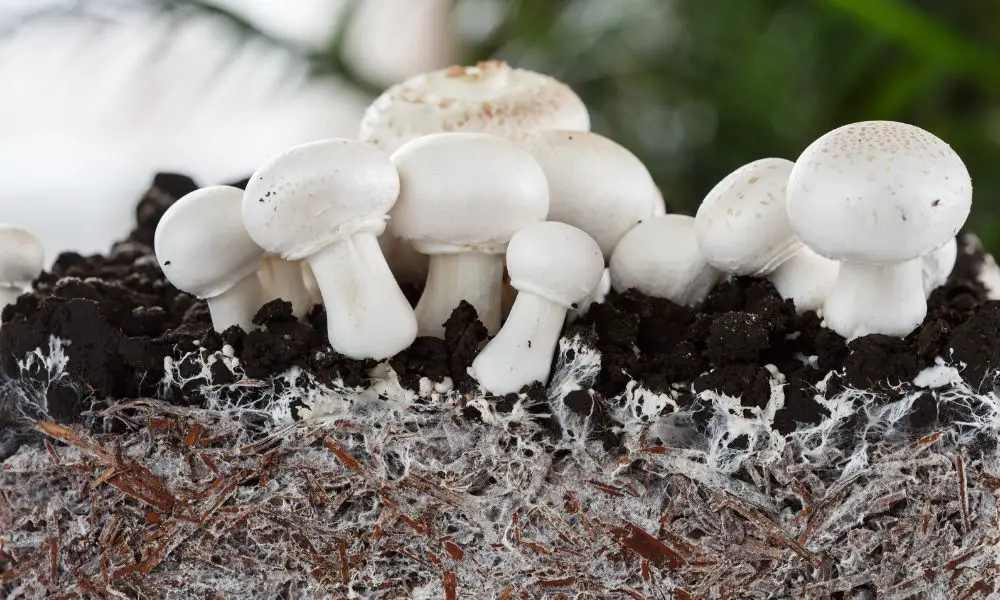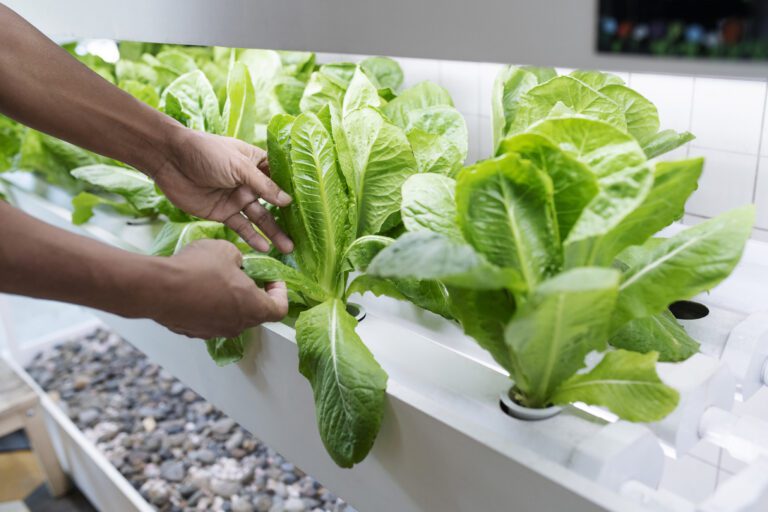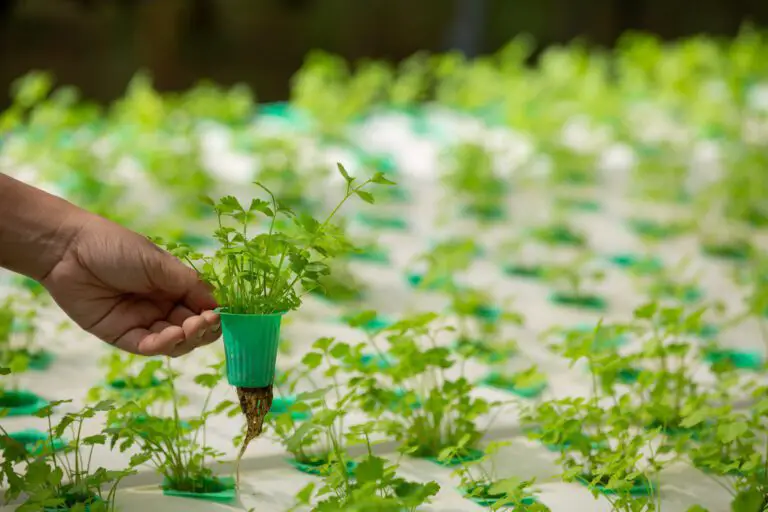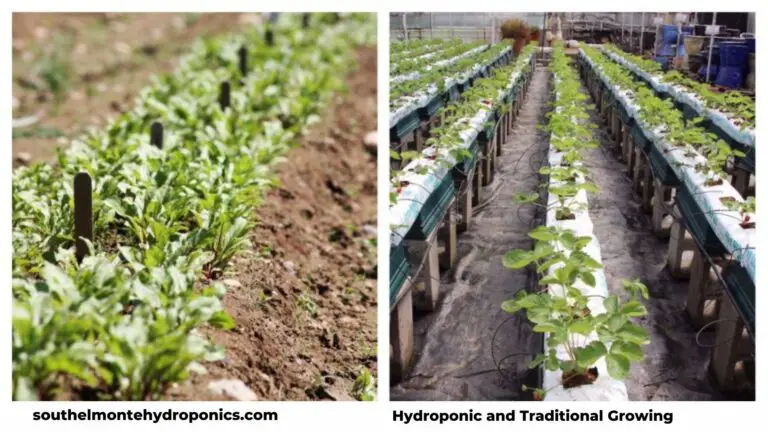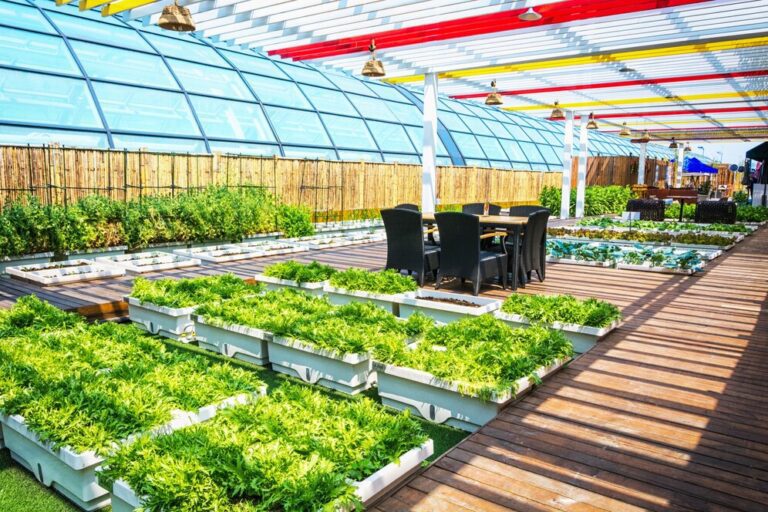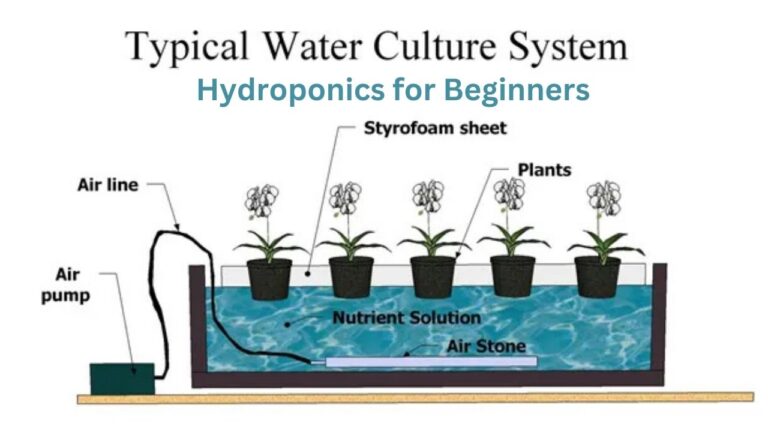The Complete Guide to Growing hydroponic mushroom farming
Did you know that you can grow mushrooms in water? Yes, you read that right. Hydroponic mushrooms farming are mushrooms that are grown in a water-based solution instead of soil. This method allows for more control over the growing conditions and can result in faster growth, higher yields, and better quality mushrooms.
Hydroponic mushrooms are also more nutritious and flavorful than conventional mushrooms, and they can be grown in less space and with less maintenance. Sounds too good to be true, right? Well, it’s not. In this blog post, you will learn how to grow hydroponic mushrooms from scratch, using simple and affordable materials that you can easily find online or at your local garden store.
You will also learn the benefits of growing hydroponic mushrooms, the different types of hydroponic systems and nutrient solutions that you can use, the best growing medium and spawn for your mushrooms, and how to set up and maintain your hydroponic mushroom farm. Let’s get started!
Table of Contents
What are Hydroponic Mushrooms and Why Grow Them?
Hydroponic mushrooms are mushrooms that are grown in a water-based solution instead of soil. Unlike conventional mushrooms, which rely on organic matter in the soil to obtain nutrients, hydroponic mushrooms absorb nutrients directly from the water through their roots, called mycelium. Hydroponic mushrooms can be grown in any type of hydroponic system, such as deep water culture, nutrient film technique, ebb and flow, drip, aeroponic, or wicking. Hydroponics mushroom farming is a method of growing mushrooms that has many advantages over traditional methods, such as:
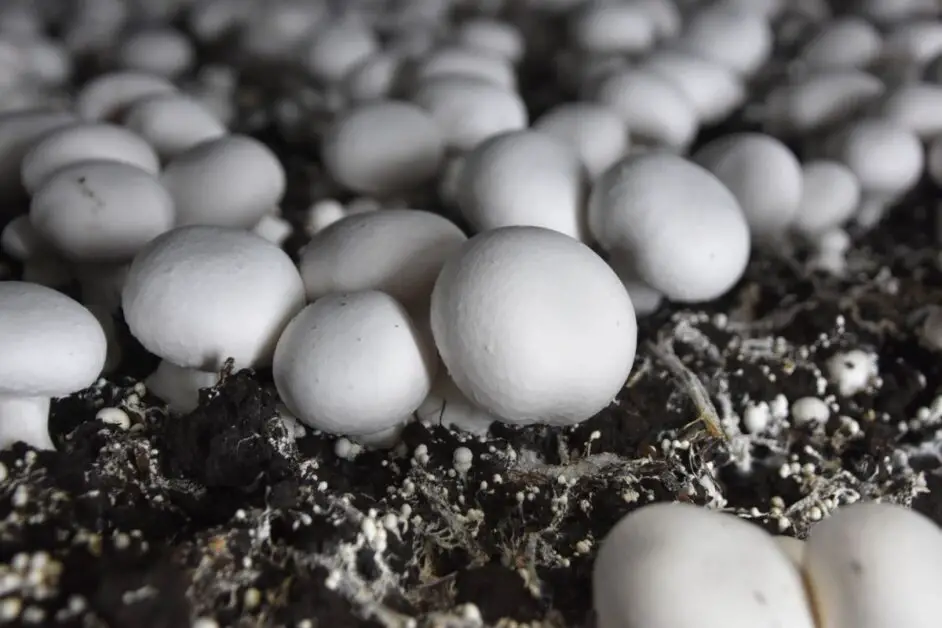
- Faster growth: Hydroponic mushrooms can grow up to twice as fast as soil-grown mushrooms, as they have constant access to water and nutrients, and do not have to compete with other organisms in the soil.
- Higher yields: Hydroponic mushrooms can produce up to four times more mushrooms per square foot than soil-grown mushrooms, as they can be grown in multiple layers, and do not have to waste energy on breaking down organic matter in the soil.
- Better quality: Hydroponic mushrooms can have better texture, color, aroma, and taste than soil-grown mushrooms, as they are not exposed to contaminants, pests, diseases, or environmental stress in the soil.
- More variety: Hydroponic mushrooms can allow you to grow a wider range of mushrooms than soil-grown mushrooms, as you can customize the water and nutrient solution to suit the specific needs and preferences of different types of mushrooms, such as shiitake, oyster, lion’s mane, button, maitake, nameko, and cinnamon cap.
- Less space: Hydroponic mushrooms can be grown in small spaces, such as indoors, on balconies, or on rooftops, as they do not require soil or light, and can be stacked vertically or horizontally.
- Less maintenance: Hydroponic mushrooms can be easier to care for than soil-grown mushrooms, as they do not require weeding, tilling, watering, or fertilizing, and can be automated with timers, pumps, and sensors.
- Higher nutritional value and flavor: Hydroponic mushrooms can have higher levels of vitamins, minerals, antioxidants, and other beneficial compounds than soil-grown mushrooms, as they can absorb more nutrients from the water, and can be enhanced with supplements, such as amino acids, enzymes, or herbs.
How to Choose the Best Hydroponic System and Nutrient Solution for Your Mushrooms
One of the most important decisions you need to make when growing hydroponic mushrooms is what type of hydroponic system and nutrient solution to use. A hydroponic system is a device or a setup that delivers water and nutrients to the roots of your mushrooms, while a nutrient solution is a liquid mixture that contains the essential elements and minerals that your mushrooms need to grow and thrive.
There are many types of hydroponic systems and nutrient solutions available, and each one has its own advantages and disadvantages. In this section, you will learn about the different types of hydroponic systems and nutrient solutions that can be used for growing mushrooms, and how to choose the best one for your mushrooms, based on their specific needs and preferences.
Types of Hydroponic Systems for Growing Mushrooms
Floating Raft Systems
One popular method is the floating raft system. Thin sheets of substrate such as polystyrene are floated on a shallow pool of nutrient-rich water inside a container. Holes are drilled or punched in the sheets to allow hyphae to penetrate down into the water below while being physically supported above the surface. As the mycelium spreads through the sheet, it absorbs nutrients circulating in the solution
Nutrient Film Technique (NFT)
NFT channels work similarly with a continuous flow of water moving along a slight incline. Blocks or slabs of inoculated substrate are placed against the sides with hyphae faces contacting the flowing film. Mushrooms grow best with a thin, uninterrupted film rather than being submerged, as turbulent flowing water brings a constant fresh supply of oxygen and nutrients to the root mass.
Deep Water Culture (DWC)
Alternatively in DWC systems, inoculated wooden logs float slightly submerged in actively bubbling nutrient reservoirs. The constant circulation of water and oxygen throughout the wood grain encourages hyphae to spread and fruiting to occur. Compared to other crops, mushrooms show impressive growth rates hydroponically through DWC with their mycelium network fully in contact with an abundance of dissolved minerals.
By taking advantage of the mycelium’s ability to absorb nutrients from a liquid medium rather than soil, hydroponic systems open new possibilities for consistent mushroom cultivation. With the right conditions, many species can thrive using thissoilless method both indoors and out, conferring crop resilience against typical field-based diseases and pests. With optimized nutrient formulations and environmental parameters, hydroponics may even support faster mycelium colonization and more bountiful mushroom harvests.
Choosing the right hydroponics mushroom varieties
When starting your first hydroponic mushroom operation, Oyster mushrooms make an ideal variety for beginners. They exhibit fast colonization rates of around 5-14 days and reliable flushes under a wide range of conditions. Several species are good options, with Pink Oysters (Pleurotus djamor) and King Oysters (Pleurotus eryngii) among the most popular.
Shiitake mushrooms have a wood-loving nature making them well-suited to logs. While more temperamental than oysters, they fruit prolifically on hardwood substrates like elm, oak, and alder over successive flushes for 1-3 years. Logs can be placed vertically or horizontally in float tanks or DWC buckets for continuous cultivation. Before inoculation, soak logs in water for several days to prep cellulose for mycelium degradation.
Turkey tail (Trametes versicolor) and lion’s mane (Hericium erinaceus) are noteworthy medicinal varieties potentially grown alongside edible species. Turkey tails have immune-boosting properties and form shelf-like growths excellent for colonizing vertical surfaces. Lion’s mane fruits fluffy white heads valued for nootropic benefits promoting nerve growth. Both grow rapidly on sterilized sawdust or wooden dowels suitable for raft float beds.
Nameko (Pholiota nameko) mushrooms possess an umami flavor enhancing soups and dishes. They fruit prolifically from cardboard or wood inoculated blocks arranged on NFT racks. Consider trying a variety to diversify harvests and take advantage of unique nutritional profiles. Experimentation is half the fun of hydroponic mushroom cultivation.
Here are some of other hydroponics mushrooms varieties:
| Mushroom Variety | Description | Yield Potential |
|---|---|---|
| Oyster Mushrooms | These fast-growing fungi boast a vibrant personality, sprouting in cascading clusters with a tantalizingly mild, nutty flavor that will elevate any dish. | High |
| Shiitake Mushrooms | Embodying the essence of umami, these sought-after mushrooms offer a rich, earthy taste that unfolds with each savory bite, making them a culinary treasure. | Moderate |
| Lion’s Mane | With its striking appearance resembling a lion’s mane, this mystical mushroom captivates not only with its looks but also with a sweet, lobster-like flavor that leaves a lasting impression on the palate. | Moderate |
| Enoki | Delicate and elegant, these slender mushrooms bring a subtle crunch to the table, complementing their mild flavor with a unique texture that adds a touch of sophistication to any dish. | Moderate |
| Reishi | Known as the “mushroom of immortality,” this revered fungus boasts a bitter, earthy flavor that signifies its potent medicinal properties, making it a cherished addition to health-conscious lifestyles. | Low |
| King Oyster | Majestic in size and taste, these regal mushrooms offer a meaty, umami-rich experience that satisfies even the most discerning palates, ensuring a royal feast with every harvest. | High |
| Maitake (Hen of the Woods) | Bursting with flavor and character, these mushrooms grow in captivating clusters, delivering an earthy and spicy taste that embodies the essence of culinary adventure. | Moderate |
Equipments for hydroponic mushrooms
Along with choosing mushroom varieties, assemble the necessary equipment for your desired system style. Lighting is essential, with T5 HO or LED panels providing high intensities optimal for fruiting. A submersible aquarium pump oxygenates water while an air stone breaks bubbles into fine mist mycelium readily absorbs. Drill holes in a plastic container, bucket, or tank to accept tubing delivering air and designing your system.
Insulated coolers or plastic utility tubs make economical float tanks fitting a single or stacking multiple shelf rafts or racks. NFT tiers stack efficiently under tubs or within cabinets for plentiful fruiting areas. Fiberglass, plastic, or wood can be cut and drilled to build rafts, racks, or specialized containers. Consider adapting IBC totes, kiddie pools or larger fish pond liners for bigger commercial projects.
Nutrient mixtures vary but incorporate easily metabolized carbohydrates, proteins, vitamins, and macro/micro minerals tailored to species. General hydroponic formulations serve as a baseline supplemented with additional corn syrup, yeast extract or other specialty “myco-tonics.” Craft a pH-buffered reservoir sufficient for regular water changes preventing build-up of metabolites and waste.
Thoroughly scrub, sanitize, and dry all plant contact surfaces to remove potential contaminants before assembling. Substrates like straw, hardwood fuel pellets, or sawdust need sterilizing through pressure cooking, dry heat, or chemical treatment to ready them for safe inoculation. Wear sterile gloves and work in clean area when transferring mycelial “spawn” to substrates starting the colonization phase. With preparation complete, you’re ready to cultivate mushrooms hydroponically!
Types of Growing Medium for Hydroponic Mushrooms
There are six main types of growing medium that can be used for hydroponic mushrooms, namely:
Sawdust: This is a fine and dry material that is made from wood shavings or chips. Sawdust is a cheap and widely available growing medium that can be used for most types of mushrooms, especially wood-loving mushrooms, such as shiitake, oyster, and lion’s mane. Sawdust can retain water and nutrients well, and it can also be mixed with other materials, such as straw, coffee grounds, or cardboard, to improve its texture and nutrient content. However, sawdust can also be prone to contamination and compaction, and it may require sterilization or pasteurization before use.
Straw: This is a coarse and fibrous material that is made from the stems of cereal crops, such as wheat, barley, or rice. Straw is a cheap and widely available growing medium that can be used for most types of mushrooms, especially straw-loving mushrooms, such as oyster, button, and nameko. Straw can provide good aeration and drainage, and it can also be mixed with other materials, such as sawdust, coffee grounds, or cardboard, to improve its water and nutrient retention. However, straw can also be prone to contamination and decomposition, and it may require sterilization or pasteurization before use.
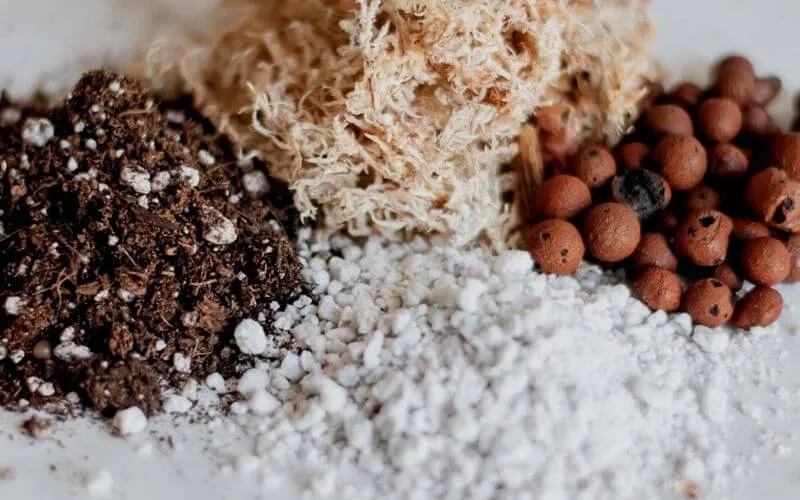
Wood chips: These are small and irregular pieces of wood that are usually obtained from hardwood trees, such as oak, maple, or birch. Wood chips are a moderately priced and moderately available growing medium that can be used for some types of mushrooms, especially wood-loving mushrooms, such as shiitake, oyster, and lion’s mane. Wood chips can provide good aeration and drainage, and they can also last longer than sawdust or straw, as they are more resistant to decomposition. However, wood chips can also be prone to contamination and drying out, and they may require soaking or boiling before use.
Coffee grounds: These are the leftover grounds that are obtained from brewing coffee. Coffee grounds are a free and readily available growing medium that can be used for some types of mushrooms, especially coffee-loving mushrooms, such as oyster, button, and enoki. Coffee grounds can provide good water and nutrient retention, and they can also be mixed with other materials, such as sawdust, straw, or cardboard, to improve their aeration and drainage. However, coffee grounds can also be prone to contamination and acidity, and they may require sterilization or pasteurization before use.
Cardboard: This is a thin and flat material that is made from paper pulp. Cardboard is a cheap and widely available growing medium that can be used for some types of mushrooms, especially cardboard-loving mushrooms, such as oyster, button, and shiitake. Cardboard can provide good aeration and drainage, and it can also be mixed with other materials, such as sawdust, straw, or coffee grounds, to improve its water and nutrient retention. However, cardboard can also be prone to contamination and decomposition, and it may require sterilization or pasteurization before use.
Grain: This is a hard and round material that is obtained from cereal crops, such as wheat, barley, or rice. Grain is a moderately priced and moderately available growing medium that can be used for some types of mushrooms, especially grain-loving mushrooms, such as maitake, reishi, and truffle. Grain can provide good water and nutrient retention, and it can also be mixed with other materials, such as sawdust, straw, or coffee grounds, to improve its aeration and drainage. However, grain can also be prone to contamination and sprouting, and it may require sterilization or pasteurization before use.
Types of Spawn for Hydroponic Mushrooms
There are three main types of spawn that can be used for hydroponic mushrooms, namely:
Grain spawn:
This is a material that is made from grains, such as wheat, barley, or rice, that are inoculated with the mycelium of the mushroom species that you want to grow.
Grain spawn is a widely available and easy to use spawn that can be used for most types of mushrooms, especially grain-loving mushrooms, such as maitake, reishi, and truffle. G
rain spawn can provide good water and nutrient retention, and it can also be mixed with other materials, such as sawdust, straw, or coffee grounds, to improve its aeration and drainage. However, grain spawn can also be prone to contamination and sprouting, and it may require sterilization or pasteurization before use.
Sawdust spawn:
This is a material that is made from sawdust, such as wood shavings or chips, that are inoculated with the mycelium of the mushroom species that you want to grow.
Sawdust spawn is a moderately available and moderately easy to use spawn that can be used for some types of mushrooms, especially wood-loving mushrooms, such as shiitake, oyster, and lion’s mane.
Sawdust spawn can provide good water and nutrient retention, and it can also be mixed with other materials, such as straw, coffee grounds, or cardboard, to improve its texture and nutrient content. However, sawdust spawn can also be prone to contamination and compaction, and it may require sterilization or pasteurization before use.
Plug spawn:
This is a material that is made from small and cylindrical pieces of wood, such as dowels or pegs, that are inoculated with the mycelium of the mushroom species that you want to grow.
Plug spawn is a moderately available and moderately easy to use spawn that can be used for some types of mushrooms, especially wood-loving mushrooms, such as shiitake, oyster, and lion’s mane.
Plug spawn can provide good aeration and drainage, and it can also last longer than grain or sawdust spawn, as it is more resistant to decomposition. However, plug spawn can also be prone to contamination and drying out, and it may require soaking or boiling before use.
Nutrient requirements of hydroponic Mushrooms
The nutrient requirements of hydroponic mushrooms vary depending on the type of mushroom, the hydroponic system, and the nutrient solution.
| Element | Symbol | Range (mg/L) |
|---|---|---|
| Nitrogen | N | 50-150 |
| Phosphorus | P | 10-50 |
| Potassium | K | 50-200 |
| Calcium | Ca | 50-200 |
| Magnesium | Mg | 25-100 |
| Sulfur | S | 25-100 |
| Iron | Fe | 1-10 |
| Manganese | Mn | 0.5-5 |
| Zinc | Zn | 0.1-1 |
| Copper | Cu | 0.05-0.5 |
| Boron | B | 0.05-0.5 |
| Molybdenum | Mo | 0.01-0.1 |
| Chlorine | Cl | 0.1-10 |
Cultivating Hydroponic Mushrooms
Inoculating substrates with mushroom spawn kickstarts the growth process. Use a sterile tool to punch holes into logs, pellets or blocks, then stuff or pack each with moistened spawn. For rafts, lay spawn-coated wooden dowels or shake inoculated sawdust onto sheets. Keep everything clean to avoid contamination setbacks.
Soon, threads of advancing mycelium will appear interweaving through substrates merging into a dense white mat. Maintain parameters like 75-80°F, 16-hour light cycles and non-stop oxygenated water movement over colonization periods typically 2-4 weeks. Consistent conditions encourage rapid, even colonization throughout the garden’s full depth and breadth.
As mycelium fills substrates, observe pH, temperature, gas exchange, and flowing water quality ensuring optimal environments. Make adjustments like stirring reservoirs or modifying light/dark cycles. Overly ‘fluffy’ growth possibly needs increased aeration or nutrients upgraded from basic to ‘fruiting-optimized’ formulations.
Shelf mushrooms arise amid clumps resembling fairy gardens. Carefully twist, cut or snap clusters from supporting substrates remembering intact hyphae left behind will often resprout second and third flushes. Harvest promptly before gills discolor or caps open fully for best texture. Store chilled mushrooms up to 5 days.
General Tips to consider when growing mushrooms hydroponically
Diseases and infections: To prevent diseases and infections, you should keep your hydroponic system clean and sterile, and avoid contaminating your growing medium and spawn with dirty tools, hands, or water.
You should also monitor your mushrooms regularly for any signs of mold, rot, or pests, and remove any infected or damaged mushrooms as soon as possible. If you notice any disease or infection spreading, you should isolate the affected mushrooms and treat them with a fungicide or an insecticide, or dispose of them safely.
Water timings: To provide adequate water to your mushrooms, you should use a pump, a timer, and a network of tubes and emitters to deliver the nutrient solution to the growing medium and the spawn. You should adjust the frequency and duration of the water cycles according to the type of mushroom, the hydroponic system, and the environmental conditions.
Generally, you should water your mushrooms more often and for longer periods during the fruiting stage, and less often and for shorter periods during the incubation stage. You should also check the moisture level of the growing medium and the spawn regularly, and make sure they are neither too wet nor too dry.
Environmental conditions: To create optimal environmental conditions for your mushrooms, you should control the temperature, humidity, light, and oxygen levels of your growing area. You should adjust these factors according to the type of mushroom, the stage of growth, and the season.
Generally, you should keep the temperature between 60°F and 75°F (15.6°C and 23.8°C), the humidity between 80% and 95%, the light between 8 and 12 hours per day, and the oxygen level between 18% and 21%. You can use a heater, a fan, a humidifier, a dehumidifier, a light, and an air pump to regulate these factors. You should also monitor them regularly with a thermometer, a hygrometer, a light meter, and an oxygen meter, and adjust them if necessary.
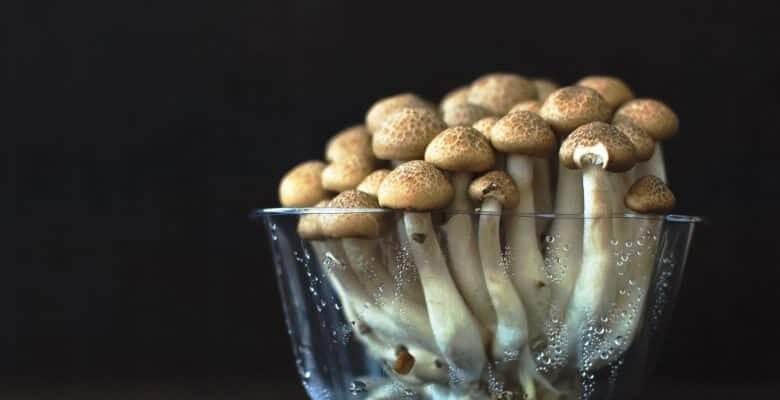
Nutrients and fertilizers: To provide sufficient nutrients and fertilizers to your mushrooms, you should prepare a nutrient solution that contains the essential elements and minerals that your mushrooms need, such as nitrogen, phosphorus, potassium, calcium, magnesium, sulfur, iron, manganese, zinc, copper, boron, molybdenum, and chlorine.
You should also adjust the pH and EC levels of the nutrient solution to suit the specific needs and preferences of your mushrooms. Generally, you should keep the pH between 5.5 and 6.5, and the EC between 1.0 and 2.0 mS/cm. You can use a pH meter, an EC meter, and a pH adjuster to measure and adjust these levels. You should also change the nutrient solution every two weeks or as needed.
Spawn: To propagate your mushrooms, you should use a spawn that is inoculated with the mycelium of the mushroom species that you want to grow. You should choose a spawn that is suitable for the type of mushroom, the growing medium, and the hydroponic system that you use. You should also choose a spawn that is fresh, clean, and potent.
You can buy a ready-made spawn from a reputable supplier, or you can make your own spawn from fresh mushrooms, spores, or cultures. You should store your spawn in a dark and cool place, and use it within a month.
Different types of mushrooms have different preferences and requirements for their growing medium, hydroponic system, nutrient solution, and environmental conditions. Here are some specific guides for some of the most popular types of mushrooms that can be grown hydroponically:
Shiitake mushrooms:
Shiitake mushrooms are wood-loving mushrooms that can be grown in sawdust, wood chips, or plug spawn. They can be grown in any type of hydroponic system, but they prefer NFT or drip systems.
They need a nutrient solution that is rich in nitrogen and potassium, and has a pH of 5.5 and an EC of 1.5 mS/cm. They need a temperature of 70°F to 75°F (21.1°C to 23.8°C), a humidity of 85% to 90%, a light of 10 to 12 hours per day, and an oxygen level of 20% to 21% during the fruiting stage, and a temperature of 60°F to 65°F (15.6°C to 18.3°C), a humidity of 80% to 85%, a light of 8 to 10 hours per day, and an oxygen level of 18% to 19% during the incubation stage.
Oyster mushrooms:
Oyster mushrooms are straw-loving mushrooms that can be grown in straw, sawdust, coffee grounds, or grain spawn. They can be grown in any type of hydroponic system, but they prefer DWC or ebb and flow systems.
They need a nutrient solution that is rich in nitrogen and phosphorus, and has a pH of 6.0 and an EC of 1.5 mS/cm. They need a temperature of 65°F to 70°F (18.3°C to 21.1°C), a humidity of 90% to 95%, a light of 10 to 12 hours per day, and an oxygen level of 20% to 21% during the fruiting stage, and a temperature of 60°F to 65°F (15.6°C to 18.3°C), a humidity of 85% to 90%, a light of 8 to 10 hours per day, and an oxygen level of 18% to 19% during the incubation stage.
Lion’s mane mushrooms:
Lion’s mane mushrooms are wood-loving mushrooms that can be grown in sawdust, wood chips, or plug spawn. They can be grown in any type of hydroponic system, but they prefer NFT or drip systems.
They need a nutrient solution that is rich in nitrogen and potassium, and has a pH of 5.5 and an EC of 1.5 mS/cm.
They need a temperature of 65°F to 70°F (18.3°C to 21.1°C), a humidity of 85% to 90%, a light of 10 to 12 hours per day, and an oxygen level of 20% to 21% during the fruiting stage, and a temperature of 60°F to 65°F (15.6°C to 18.3°C), a humidity of 80% to 85%, a light of 8 to 10 hours per day, and an oxygen level of 18% to 19% during the incubation stage.
Button mushrooms:
Button mushrooms are compost-loving mushrooms that can be grown in manure, compost, or grain spawn. They can be grown in any type of hydroponic system, but they prefer ebb and flow or wicking systems.
They need a nutrient solution that is rich in nitrogen and phosphorus, and has a pH of 6.0 and an EC of 2.0 mS/cm.
They need a temperature of 60°F to 65°F (15.6°C to 18.3°C), a humidity of 80% to 85%, a light of 8 to 10 hours per day, and an oxygen level of 18% to 19% during the fruiting stage, and a temperature of 55°F to 60°F (12.8°C to 15.6°C), a humidity of 75% to 80%, a light of 6 to 8 hours per day, and an oxygen level of 16% to 17% during the incubation stage.
Maitake mushrooms:
Maitake mushrooms are grain-loving mushrooms that can be grown in grain, sawdust, or straw spawn. They can be grown in any type of hydroponic system, but they prefer ebb and flow or drip systems.
They need a nutrient solution that is rich in nitrogen and potassium, and has a pH of 6.0 and an EC of 1.5 mS/cm.
They need a temperature of 65°F to 70°F (18.3°C to 21.1°C), a humidity of 85% to 90%, a light of 10 to 12 hours per day, and an oxygen level of 20% to 21% during the fruiting stage, and a temperature of 60°F to 65°F (15.6°C to 18.3°C), a humidity of 80% to 85%, a light of 8 to 10 hours per day, and an oxygen level of 18% to 19% during the incubation stage.
Watch thos video to learn more about hydroponics mushrooms.
Conclusion:
Hydroponic mushroom cultivation offers various advantages over outdoor methods like increased yields within smaller footprints, pest and weather resistance supporting continuous production. For commercial growers, precisely managed indoor systems optimize output and value. Home hobbyists enjoy nutritional, garden-fresh mushrooms while exploring culinary varieties. With patience and sterile technique, year-round harvests become reality through this sustainable agricultural practice.
Frequently Asked Questions about Hydroponic Mushroom Growing
Can any mushroom be grown hydroponically?
While oysters, shiitakes, lions mane and others thrive hydroponically, not all mushroons are suited. Those with strong wood-decomposing natures like reishi do best with solid woody substrates. Experimentation reveals each species’ preferences.
What nutrients do mushrooms need in hydroponics?
Macronutrients include nitrogen, phosphorus, potassium and calcium. Micronutrients include selenium, iron and zinc. Mushrooms also require simple carbohydrates, proteins and vitamins B & D supplied in solutions tailored to different species’ needs.
How do I prevent contamination in my system?
Maintain strict sterilization of all equipment, substrates and work areas. Do not work when sick. Introduce spawn to substrates inside still-sealed bags in front of filtered airflow. Monitor for off-color mycelium patches signaling disease and isolate/remove immediately.
Can hydroponic mushrooms be grown indoors year-round?
Absolutely. With artificial lighting, temperature/humidity control hydropnic systems produce consistent, pest-free crops 365 days a year. Indoor operations can be scaled up or down year-round based on demand.

